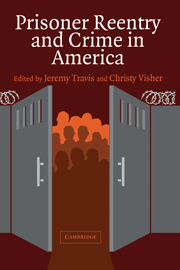Book contents
- Frontmatter
- Contents
- List of Contributors
- 1 INTRODUCTION
- 2 FROM CELL TO SOCIETY
- 3 REENTRY AS A TRANSIENT STATE BETWEEN LIBERTY AND RECOMMITMENT
- 4 THE CONTRIBUTION OF EX-PRISONERS TO CRIME RATES
- 5 DOES SUPERVISION MATTER?
- 6 THE IMPACT OF IMPRISONMENT ON THE DESISTANCE PROCESS
- 7 COMMUNITIES AND REENTRY
- 8 WORK AND FAMILY PERSPECTIVES ON REENTRY
- 9 CONSIDERING THE POLICY IMPLICATIONS
- Index
8 - WORK AND FAMILY PERSPECTIVES ON REENTRY
Published online by Cambridge University Press: 05 June 2012
- Frontmatter
- Contents
- List of Contributors
- 1 INTRODUCTION
- 2 FROM CELL TO SOCIETY
- 3 REENTRY AS A TRANSIENT STATE BETWEEN LIBERTY AND RECOMMITMENT
- 4 THE CONTRIBUTION OF EX-PRISONERS TO CRIME RATES
- 5 DOES SUPERVISION MATTER?
- 6 THE IMPACT OF IMPRISONMENT ON THE DESISTANCE PROCESS
- 7 COMMUNITIES AND REENTRY
- 8 WORK AND FAMILY PERSPECTIVES ON REENTRY
- 9 CONSIDERING THE POLICY IMPLICATIONS
- Index
Summary
Employment and marriage play central roles in standard analyses of recidivism, and a long line of research suggests that ex-offenders who find good jobs and settle down in stable marriages threaten public safety much less than those who remain single and unemployed. Successful prisoner reentry thus involves the linked processes of reintegration into social institutions such as work and family and desistance from crime. Therefore, research on reentry and recidivism often aims to identify factors that place people at risk of joblessness and marital disruption – low education, impulsive behavior, drug abuse and so on. From this perspective, the job of public policy is to remedy these preexisting defects in ex-offenders, thereby promoting employment, marriage, and ultimately reducing crime.
In this chapter we reexamine the roles of employment and marriage in prisoner reentry. Although we certainly agree that good jobs and strong marriages assist successful reentry and reduce recidivism, we try to extend the usual analysis in three ways. First, we adopt a life course perspective in which the timing of work and marriage emerge as critical for desistance from crime. This perspective suggests that age-graded public policy interventions are needed to normalize the life course trajectories of ex-offenders. Second, we consider whether the criminal justice system – particularly corrections – might negatively affect the employment opportunities and marriage prospects of ex-offenders. In this case, public policy should also work to remedy the damage caused by official criminal justice processing or to seek alternatives to incarceration that may be less costly to public safety in the long term.
- Type
- Chapter
- Information
- Prisoner Reentry and Crime in America , pp. 209 - 243Publisher: Cambridge University PressPrint publication year: 2005
- 64
- Cited by

